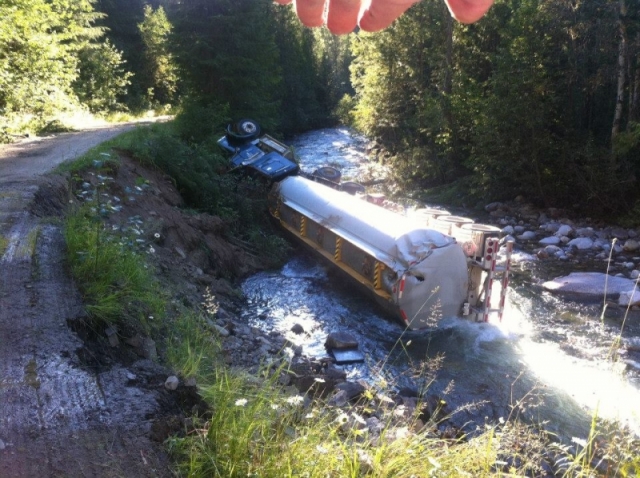Interior Health review of Lemon Creek spill reveals gaps in response, recommendations for improvement
Interior Health (IH) has sifted through the details of its response to the 2013 Lemon Creek fuel spill in the Slocan Valley, and determined that responses to future incidents like this need to be faster and better coordinated.
The spill happened on July 26, 2013 when a truck delivering jet fuel for helicopters fighting a forest fire on Perry Ridge made a wrong turn and tipped over – spilling fuel into Lemon Creek and the Slocan River.
The report, the full details of which can be found online here, outlines the key areas in which IH feels the response was lacking along with some lessons learned with recommendations to address them.
And while IH Regional Director for Health Protection, Roger Parsonage says he’s proud of the work his team put in on the response, and how well people came together from different parts of the organization to support the response, he adds that there were two main areas in the response where gaps were found.
“One is, we didn’t have a well-developed structure for our response,” Parsonage said.
“The second is that we need to ramp up quicker. And the big lesson is that we needed to pull in more staff earlier in the response to be more efficient. We had the right people in the first 48 hours; we just didn’t have enough of them.”
Parsonage added that getting more staff on the ground and creating a better structure for responses are amongst the key findings of the review.
“We need to have a defined structure for our response and hand-in-hand with that is to have a clear process for activating staff after hours,” he said.
“ . . . The biggest lesson I’ve taken away from this is if this type of event was to happen again, we need to bring in more staff more quickly to really insure we’ve got enough people to respond to the needs of whatever that event is.”
Parsonage said some of the recommendations have already been implemented and others have interim measures put in place to address the most significant gaps in the response process.
IH plans to work over the next few months to fill everything in and make the process permanent.
“What we intend to do when we finalize some details of the response is, we will drill it, test it in exercises and then review those results. We’ll continue to make improvements as we identify the need. We will also continue to conduct a review any time we do a response to an event.”
Parsonage added that IH got to test out some of its new processes and procedures in the aftermath of the Mount Polley tailings ponds breach, that happened earlier this year in Northern BC.
“In my view, the lessons from Lemon Creek have already made an impact on how we respond,” Parsonage noted.


























